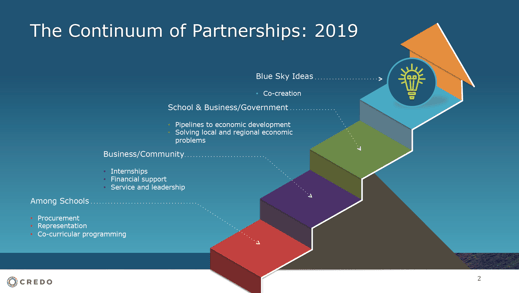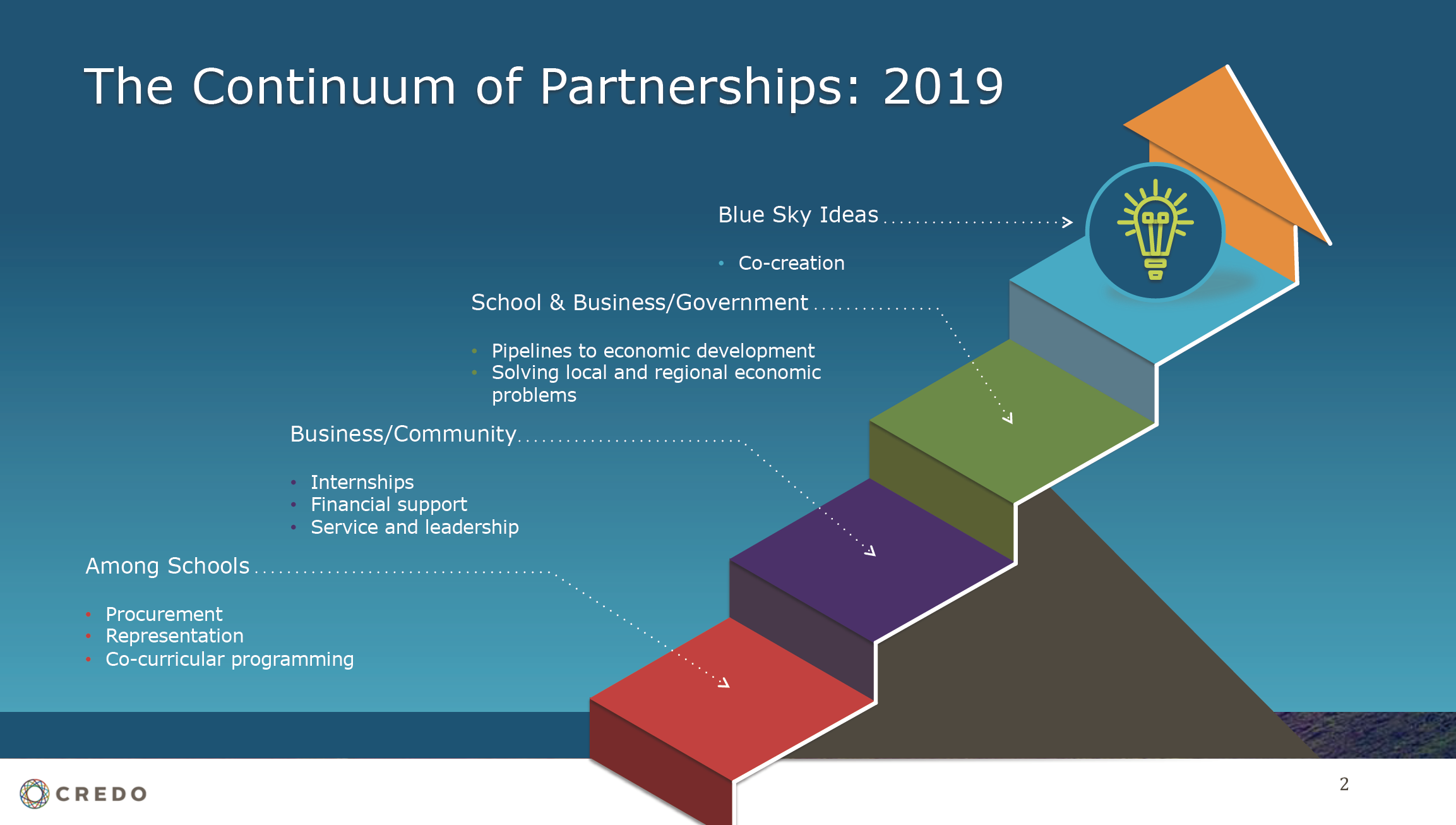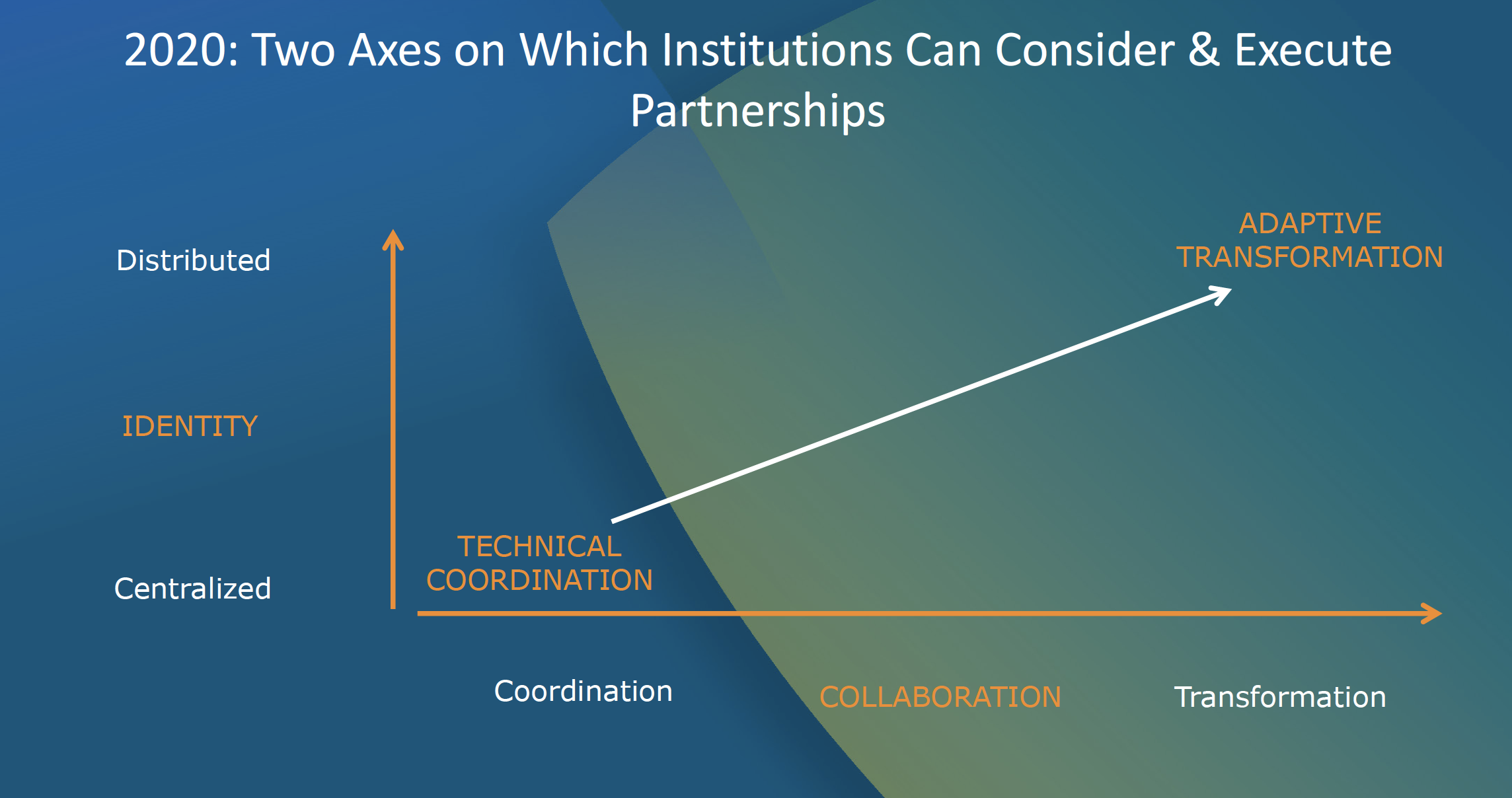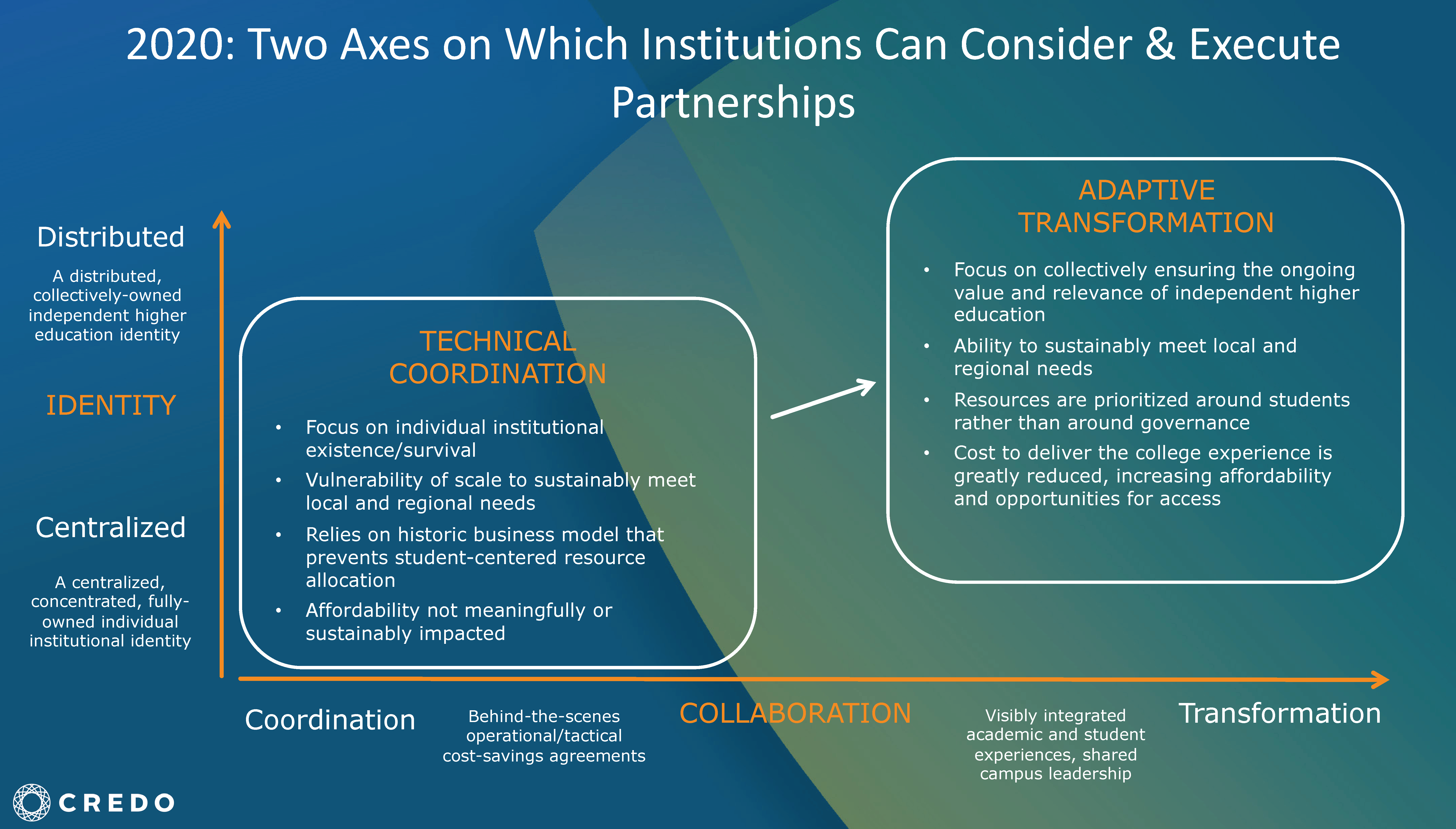
July 2 2020
“We’re coming to the table holding nothing sacred,” said one president, sharing that their institution was deep in a merger conversation with another college in their region. “Not the mascots, not our physical campuses, not even our individual missions. What is sacred is the viability of independent higher education in our region and we think together, everything from our balance sheet to our value proposition will have more power.”
By Emma Jones & Joretta Nelson, Ph.D.
As a consulting firm, Credo has been engaged in merger conversations for years, but this most recent conversation, like others that have followed in the last several weeks, demonstrates a shift in mindset for leaders approaching this difficult work. The idea of merging institutions is not new, nor is the expressed value of collaboration among institutions. Historically, though, in Credo’s experience, it has been rare for mergers or deep collaborations to come to fruition—board resistance, alumni opposition, disparity of assets, perceived but often false senses of value proposition, and power-struggles often derailed the most promising consolidation ventures.
As the global COVID-19 pandemic and vast civil and political unrest reshape higher education through 2020 and beyond, attention to the role partnerships will play in the strategic future of colleges and universities all over the country is on the rise. How we define partnerships in this time, we believe, may require something different—softening the tightly-guarded borders around individual institutional identity in favor of a more collective approach to sustaining our sector of independent higher education into the future.
“There’s a lot we’d like to change about ourselves that we could inherit overnight in a merger,” said another president. “We have to look at this process as strategic optioning—what allows our students to be best served into the future?”
We’ve talked for quite some time about a continuum of partnerships, explicated in Joanne Soliday and Mark Lombardi’s book “Pivot: A Vision for the New University.” This continuum moves from operational and cost-saving agreements, to community engagement, to local/regional business and government partnerships. This model represents a broad spectrum of engagement that we see being lived out on our partner campuses in a variety of ways, all of which are useful and helpful, and many of which serve the campus, students, and community well. You could say that this continuum moves from coordination, to cooperation, to collaboration in depth and complexity.

A core assumption across these types of agreements is that institutional identity remains intact. The vast majority of colleges and universities have a focused or centralized identity, shaped around their own specific missions, histories, values, geographies, and student bodies. Partnership possibilities are approached with this identity as a baseline and and are often evaluated by the degree to which that identity will be reinforced or threatened.
But 2020 has broken open the model of higher education in an unprecedented way. As the global pandemic exacerbates existing financial and operational stress and challenges the value proposition of colleges and universities across the country, both institutions and leaders are coming to the table differently in this moment to push the boundaries of identity in the context of partnerships.
Change readiness is presenting itself in new ways as leaders demonstrate:
- Vulnerability: Years of collective cost-savings measures (collaborative buying programs, shared retirement plans across institutions, etc.) have failed to meaningfully reduce the cost of higher education. Leaders now have a greater vulnerability about challenges the pandemic has surfaced in the higher education business model, opening the door for more honest and real conversations about viability.
- Willingness: We’re seeing an increased willingness to move beyond individual institutional survival to focus on the ultimate goal of ensuring that the values of liberal arts learning are sustained in service to students across time.
And as institutions demonstrate:
- Agility: A newly-discovered agility born of the extraordinary reorientation of the entire spring semester from in-person to distance learning at most colleges and universities across the country was a shift which, however imperfect in its daily operation and execution, showed us all that rapid change is possible in higher education.
- Freedom: Governance structures at colleges and universities, from the board of trustees to the faculty senate, often present the greatest blockers to innovation and change on any college campus, but the upheaval of the pandemic has, in many cases, exposed to a broader audience the need for new ways of thinking and doing in higher education, and created a narrow window of freedom for colleges and universities to dramatically reinvent themselves.
“The real key to understanding our ability to emerge from this global crisis is knowing what the fall of 2021 looks like, not the fall of 2020,” one president shared. “But frankly, we may not have that long to wait to see if we’re going to make it in our current form.”
This powerful combination of vulnerability, willingness, agility, and freedom rising from the ashes of the spring semester is driving a new type of conversation about deep collaboration between institutions, with institutional identity emerging as the frontier on which the next wave of creative mergers and consolidations are likely to happen. Credo posits that heightened levels of collaboration combined with a de-centralization of institutional identity will define a new continuum of partnerships for the future.

In this model, two axes drive the development and execution of partnerships:
Collaboration, moving from:
- Coordination: like behind-the-scenes operational/tactical cost-savings agreements, to
- Transformation: from visibly integrated academic and student experiences all the way to shared campus leadership and/or a complete merging of institutions.
And Identity, moving from:
- Centralized: a centralized, concentrated, fully-owned individual institutional identity, to
- Distributed: a distributed, collectively-owned independent higher education identity.
The result is a new continuum that moves from technical coordination of operational efforts on one end to adaptive transformation across institutions on the other.

In this model:
- A focus on individual institutional existence morphs into a focus on collectively ensuring the ongoing value and relevance of independent higher education.
- The driver for an institution to meet its local and regional needs is strengthened through a shared, collective platform.
- The business model moves from being institution-centric to student-centric; the focus on efficiencies is not around institutional survival but around student learning, completion, and transformation.
- And finally, the cost to deliver the college experience is greatly reduced, increasing affordability and opportunities for access.
Clearly this is still a time to build partnerships along the traditional cooperation continuum; asking questions about how we might move from simple coordination to strategic collaboration. However, Credo believes it is time to ask the more difficult questions of our industry—about our ultimate purpose, about the model that limits our ability to serve our students, about how we might begin to think and act as a collective. The extraordinary uncertainty of the coming years is pushing leadership to think and act with heightened urgency, scenario planning with a breadth and depth that has never been required. Instead of “how will we survive until 2021?” we would suggest it is time to ask, “What could we achieve for our students if we removed our own institutional identity as a constraint to partnerships and entered into conversations with all of our assets on the table, for the sake of students? Why not now?”
What do you think about the readiness for partnerships that push the boundaries of institutional identity? How and where are these conversations taking place within your leadership?
Download the accompanying slide deck that shows the Continuum of Partnerships model, and how it has changed dramatically in 2020. Do you agree with this model and the trajectory it presents? What would you add?
,Tell us what you're thinking about or ask us your questions by starting a conversation with Credo.
Related Blog Posts
Recent Posts
- Richard Dunsworth, J.D., To Receive 12th Annual Courageous Leadership Award December 16 2024
- Meet the 2024 Credo Values Award Recipients August 27 2024
- What is Executive Coaching, Really? June 25 2024
- Credo & The Constructive Dialogue Institute Announce A New Partnership For Higher Education Leadership Development March 7 2024
- Celebrating Women And Gender-Diverse Learners & Leaders February 28 2024
Categories
- Strategy
- Leadership
- Student Success
- Student Success & Retention
- Enrollment
- Pivot
- Strategic Planning
- Leadership Development
- News
- Strategic Enrollment
- Campus Planning and Architecture
- Moving the Needle
- Data
- Research
- Retention
- Campus Master Planning
- Enrollment & Financial Aid
- Academic Programming
- Campus Planning
- Thriving
- Admitted Student Research
- Architecture
- Finance
- Advising
- Admissions





